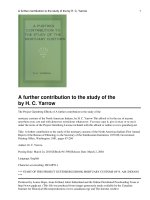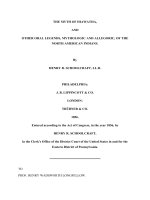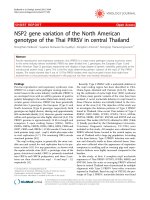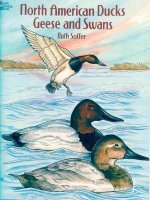The north American Sylva V03, Michaux 1819
Bạn đang xem bản rút gọn của tài liệu. Xem và tải ngay bản đầy đủ của tài liệu tại đây (22.22 MB, 401 trang )
,
THE
NORTH AMERICAN
SYLVA,
O R
A DESCRIPTION OF THE FOREST TREES
OF THE
UNITED STATES CANADA AND NOVA SCOTIA,
,
Considered particularly with respect to their use in the Arts,
and
their introduction into
TO -WHICH
Commerce
;
ADDED
IS
A DESCRIPTION OF THE MOST USEFUL OF THE EUROPEAN FOREST
TREES.
l56 COLOURED ENGRAVINGS.
ILLUSTRATED BY
Translated from the French of
F;
MemLer
ANDREW MICHAUX, HIO-K^^S"
of the American Philosophical Society of Philadelphia
the Institute ofjrance;
Member
Philadelphia and Massachusetts; Honorary
Philosophical Societies of
;
Correspondent of
of the Agricultural Societies of Charleston
Member
,
S. C.
of the Historical, Literary
and
New York.
.
.
arbore sulcamus maria
arbore extedificamus
,
lerrasque admovemut,
tecta.
Plinii secondi: Nat.
VOL.
III.
PARIS,
PRINTED BY
C.
D'HAUTEL.
1819.
Hist.
,
lib. xir.
-^A«-.<
v'^
V.
.
/'/
C'abUaoe JVee.
///.
uji/uvroiK^'
^7t>^K'
vaJjiWiW
THE
NORTH AMERICAN
SYLP^A.
v^*v^vvvvvvvvvvwv^)VVV»VVVvvvvvvvvvv»AAwvv^A(v^^^lv^^vvvvvvvvvvvvvvvvvwvvvvvvvvvvv^/vv\v^
CABBAGE TREE.
Hexandria trigynia. Linn.
ChaM-EROPS PALMETO.
From
its
cauh arhoreo ; frondibus pal-
C.
matis, plicaiis,
stipitibiis
lofty height,
it
non
aculeatis.
this vegetable is considered in
the United States as a tree
Ocean, where
Palma?. Juss.
grows,
and upon the shores of the
;
it
is
called
belongs to the genus of the Palms
,
Cabbage Tree.
It
and is found farther
north than any other species in America, being
frrst
seen
about Cape Hatteras, in the 34th degree of latitude,
which, in the temperature of the winter, corresponds
with the 44th in Europe.
From Cape
to the extremity of East Florida,
the Gulf of Mexico
in
:
I
have no doubt that
Cuba and the Bahama
muda, which
is
Hatleras
Isles
more than 600
;
it
and probably
I
spreads
encircles
exists also
it
have seen
it
in Ber-
miles from the coast of
North America.
Farther south the Cabbage Tree
the United States
III.
,
to the
is
immediate
not confined
vicinity
,
as in
of the seaj
I
,
CABBAGE TREE.
2
on the
river St.
Lake George
,
I
John
from the
tance of 4o or 5o miles
A
in Florida
,
,
a
few miles above
caused two stocks to be felled at the dis-
trunk from 4^ to 5o
shore.
feet in height
,
of an
uniform
diameter, and crowned wdth a regular and tufted sum-
mit gives the Cabbage Tree a beautiful and majestic ap,
pearance.
Its leaves
and borne by
triangular
are of a brilliant green
petioles
and united
and breadth from
i
from
at
1
,
palmated
8 to 24 inches long, nearly
the edges
foot to 6 feet,
;
they vary in length
and are so arranged
that the smallest occupy the centre of the
summit, and
the largest the circumference. Before their develope-
ment they
are folded like a fan
outside sticks break off and
,
and
fall,
rounded with filaments woven
as they
open the
,
leaving the base sur-
into a coarse
and flimsy
russet web.
The base of the undisclosed bundle of leaves
compact and tender;
it
is
eaten with
oil
and resembles the artichoke and the cabbage
whence
is
derived the
name of Cabbage
is
white,
and vinegar,
in taste,
Tree. But to
destroy a vegetable which has been a century in grow-
ing
,
to obtain three or four
neither richly nutritious
palate
,
ounces of a substance
nor peculiarly agreeable to the
would be pardonable only
in a desert
destined to remain uninhabited for ages.
prodigality of the
Kentucky
1
works of Nature, the
killed the Buffalo,
5 hundred
pounds
,
which was
With
similar
first settlers
of
an animal weighing 12 or
for the pleasure of eating
its
CABBAGE TREE.
3
tongue, and abandoned the carcase to the beasts of the
wilderness.
The Cabbage Tree bears long
ish flowers
fruit
,
about the
of
size
extremely porous
:
its
inesculent
wood of this
tree,
though
preferred to every other for
is
,
,
a pea.
In the Southern States the
wharves
chisters of small green-
which are succeeded by a black
,
superiority consists in being secure
injury by sea-worms, which, during the
from
summer com,
mit such ravages in structures accessible to their attacks
but
when exposed
to be alternately
flowdng and ebbing of the tide
,
it
decays as speedily as
other wood. This use of the Cabbage Tree
minishing
distant
its
when
of the United
numbers
it
,
;
wet and dry in the
is
rapidly di-
and probably the period
will cease to exist within the
is
not
boundaries
States.
In the war of Independance the Cabbage Tree was
found eminently proper for constructing
on the passage
closes without splitting
The growth and developement
forts
,
as it
of the ball.
of the
Palms have oc-
cupied the attention of distinguished botanists, to whose
memoirs the reader
mation.
The
courage
its
is
referred for
more
accurate infor-
tardy growth of this species will always dis-
propagation.
PLATE
\A Cabbage Tree with
its
fruity
CI.
PRIDE OF INDIA.
DecanJrlamonogynJa, Linn.
Melia Azedarach, M.
This tree
is
its
Upinnatis:
foliis
a native of Persia,
flowers and the elegance of
in request in
Meliae. Juss.
For the beauty
foliage,
it
of
southern climates for embellishing towns
and adorning the environs of
dwellings.
propagated
It is
for this purpose in India, in the Isles of France
Bourbon
,
in Syria
,
Spain
,
Portugal
,
Italy
and
and the south-
New World
ern departments of France. In the
found in
its
has long been
it
is
towns of the West Indies and of South
several
America and on the Northern Continent
;
so abun-
it is
dant and so easily multiplied in the maritime parts of
the Southern Slates
ral productions.
,
as to
be ranked among their natu-
This claim
upon our
forced by the valuable properties of
attention
its
is
en-
bark and of
its
wood.
The Pride
of India rises to the height of 3o or 4o feet,
with a diameter of i5 or 20 inches
alone,
itself
visually rests at a
it
into a spacious
green colour
smooth
flowers
,
,
,
large
,
which form
of the branches
,
but,
when
smaller elevation
summit.
Its
denticulated
,
and
,
diffuses
and composed of
leaflets.
axillary clusters at the
produce a
standing
leaves are of a dark
doubly pinnate
,
acuminate
;
fine effect,
The
lilac
extremity
and exhale
a de-
PI.102
Pride of
Me ha
Tiul
ax cf/a/ -at •/
.
,
PRIDE OF INDIA.
llclous odour.
lowish
The
5
round and
ripe seeds are large,
particularly
by the red-breasts
tion to Ihe South
which
,
,
in their annual migra-
,
im-
after gorging themselves
moderately; are sometimes found stupilied by
cotic
yel-
they are sought with avidity by certain birds
;
nar-
its
power. The venomous principle which resides in
this tree
the itch
taken notice of by Avicenna, an Arabian
is
Physician
who
,
flourished about the year 980. In Persia
cured with an ointment
is
made by pounding
leaves with lard.
its
The Pride of
India prospers in a dry and sandy soil,
and magnificent stocks
ton and Savannah.
flowers,
lightful
is
are seen in the streets of Charles-
Its foliage
,
which
,
developed early in the spring
as well as the
,
affords a de-
refreshment to the eye, and yields a shelter
from the fervour of the sun during the intemperate
son.
It
grows with such
attains the
heght
rapidity, that
from the seed
is
chiefly
remarked
in stocks less
than ten years of age, in which the concentrical
it
more
circles
distant than in any other tree. Like the Locust,
possesses the valuable property of converting
into perfect
w ood
in the earliest stages
of
its
consequently
may be employed almost
of a reddish colour
that of the
the
Red
Ash
Bay, the
:
,
and
is
entire.
sap
its
growth
stock 6 inches in diameter has only an inch of sap
is
it
of 12 or i5feet in four years. This
surprising vegetation
are
sea-
,
;
a
and
The wood
similarly organized
it receives a less brilliant polish
with
than
Wild Cherry, the Maple and the Sweet
prideofindia:
6
Gum
;
but this defect
is
unimportant in a country -which
possesses the species just mentioned
cure Mahogany.
The Pride of
able and strong to be useful
and can
India
is
in building
,
easily
pro-
sufficiently
dur-
and
it
will pro-
bably be found adapted to various mechanical uses
has already been employed for puUies which
,
are
made
of
assured that
Elm
it is
,
and
in
America
;
it
Europe
in
of Ash. I have
been
excellent fuel.
This succinct description deserves attention in the
southern parts of North America, and in those countries
of
Europe where the pride
of India
is
considered as an
ornamental rather than as an viseful tree. Fields exhaust-
ed by cultivation and abandoned might be profitably
covered with
it.
PLATE
CII.
A leaf of a third part of the natural
of the natural size. Fig. i
,
size.
Fig.
Seeds of the natural
i
,
size.
Flowers
Fi.iod
PisltU'ia
Troo
vww\wvw\vwwx\
PISTACIA TREE.
Dioecia pentendria. Linn.
Therebeiithacae. Juss.
PiSTACiA YERA. P. folUs impan-pinnatis ; foUolis subofaiisy
recurvis, coruceis.
The
is
Tree
Pistacia
particularly
is
indigenous to Asia Minor and
abundant in
Syria. It equals
,
and some-
times exceeds, 25 or 3o feet in height, and has heavy,
crooked limbs clad in a thick, greyish bark, and large
leaves
lets
the
,
composed of one or two
pair of coriaceous leaf-
with a terminal odd one. This vegetable belongs to
class of dioecious plants
The barren
different stocks.
hardly apparent
and of
,
and the
a greenish
whose
sexes are
fertile
ones are likewise small
consists of thin-
colour. Its fruit
shelled oval-acuminate nuts
,
borne by
flowers are minute and
about the
size
of an olive
,
which are collected in bunches, and are commonly
yielded in profusion.
They
are of a
more
vour than the hazel-nut or almond
,
agreeable fla-
and are annually
exported to those parts of Europe and Asia where the
tree does not flourish.
The
Tree succeeds in dry, calcarious
Pistacia
grounds
,
but shuns a sandy and a humid
soil.
,
stony
In form-
ing plantations care must be taken to possess trees of
different sexes
possible
;
,
without which the fructification
one male should be
is
im-
allotted to five or six fe-
PISTACIA TREE.
8
males, and to avoid mistake, young grafted stocks should
be procured or suckers from the foot of an old
,
The wood
is
hard
resinous
,
,
tree.
excellent for fuel
,
and
proper for economical purposes.
According to Pliny, pistich-nuts were
first
brought to
Rome about
the reign of Tiberius, by Vitellius, Gover-
nor of Syria
,
Italy at the
and probably the tree was introduced into
same period.
It
has long been cultivated in
Spain, Portugal and the South of France, and,
when
protected by a wall and favoured with a southern exposure
,
it
yields fruit
the Orange Tree
mate with the
,
even
at Paris. It is less delicate
and prospers
Olive.
Though
it
in the
same
offers less
ducements than the Olive to attempt
in
West Tennessee and in
its
soil
than
and
cli-
powerful inintroduction
the Southern States
,
it
would
afford an agreeable addition to the luxuries of the table.
PLATE cm.
A branch (vith fmil of the natural
flower. Fig. i, A fertile flower. Fig. 3
posed. Fig. 4,
size.
,
Fig.
i
,
A barren
Fruit with the nut ex^
^ nut with the kernel exposed. Fig. 5, A ker-
nel without the pellicle.
J%v.-a
,iW
J. 2: J.^/v
American Cliesnut
( (uctanea
veA-ai
.',;,//.
,,
;
kvwvwwvv^
AMERICAN CHESNUT.
Monoecia polyandria. Linm.
CastANEA VESCA.
Amcntacae. Juss.
C. foliis lanceolatis
,
acuminatb-serratis
utrinque glabris; nucibus dimidio supeiiore
The Chesnut does not
gree of latitude.
It is
venture beyond the 44th de-
New
it is
New Hampshire between
found in
the 43d and the 44*^ degrees
the winter that
less
villosls.
,
but such
common than
Jersey and Pennsylvania.
It is
is
the severity of
in Connecticut
most multiplied
in
the mountainous districts of the Carolinas and of Georgia
,
and abounds on the Cumberland Mountains and in
East Tennessee.
The
coolness of the
summer and
the mildness of the
winter in these regions are favourable to the Chesnut
the face of the country, also
tree
which prefers the
mediate
vicinity
,
where the
though deep enough
The Chesnut of
the Old
a
perfectly adapted to a
mountains or their im-
soil in
to sustain
its
World
pansion in similar situations
on Mount Etna of
is
,
sides of
:
general
attains
gravelly
its
greatest ex-
is
said to exist
an example
Chesnut 160
is
perfect developement.
feet in
circumference
or about 53 feet in diameter, and large enough to shelter
100
is
men on horseback beneath its branches
hollowed by time almost to the bark
several others
III.
more than 76
:
;
but
its
near
it
trunk
stand
feet in circumference.
2
At
AMERICAN CHESNUT.
lO
Sancerre in the Department of the Cher, 120 miles from
Paris
there
,
ground,
is
a Chesnut
more than
its
600 years ago
;
and though
,
1000 years old, its trunk
from the
6 feet
at
,
3o feet in circumference
is
called the Great Chesnut
and
which
it is
is still
it
was
supposed to be
perfectly sound,
branches are annually laden with
have
fruit. I
never met with instances of such extraordinary growth
in the
United States, but the American species
ably susceptible of an equal developement
forests of
North Carolina
,
it is
,
commonly
I have
measured
several stocks
which
,
in the
,
as tall
large as the corresponding species in those of
prob-
is
since
and
as
Europe
;
from
at 6 feet
the ground, were i5 or 16 feet in circumference, and
which equalled the
The Chesnut
is
loftiest trees in stature.
a stranger to the Province of
Maine
the State of Vermont and a great part of Gennessee
the maritime parts of Virginia
gia
,
to the Carolinas
the rioridas and Louisiana as far as the
,
,
,
,
to
Geor-
mouth
of
the Ohio.
Though the American Chesnut
of
Europe
in
its
nearly resembles that
general appearance
and the properties of its wood
,
,
it is
its
foliage
,
its
fruit,
treated by botanists
as a distinct species. Its leaves are 6 or 7 inches long
inch and a half broad coarsely toothed
,
oval
ture
form
,
,
,
,
an
of an elongated
of a fme brilliant colour and of a firm tex-
with prominent parallel nerves beneath. The bar-
ren flowers are whitish
grouped on
axillary
,
unpleasant to the smell, and
peduncles 4 or 5 inches long.
The
,
AMERICAN CHESNUT.
fertile
aments are
cuous.
The
similarly disposed
,
ji
but
less
conspi-
covered with fine prickles,
fruit is spherical,
and stored with two dark brown seeds or nuts, about
end
as large as the
on one
of the finger, convex
side,
on the other, and coated round the extremity
flattened
with whitish down. They are smaller and sweeter than
the wild chesnuts of Europe
and are sold
,
New York,
bushel in the markets of
at 3 dollars a
Philadelphia and
Baltimore.
The wood
is
strong, elastic
,
and capable of enduring
the succession of dryness and moisture.
renders
it
especially valuable for posts
be made of trees
less
Its durability
which should
,
than lo inches in djameter and
charred before they are planted in the earth. In Connecticut
,
Pennsylvania and a part of Virginia
ferred for
For
rails
,
shingles this
though
it
and is
said to last
wood
is
Red Oak,
wares
is
;
are so
,
open
and
that
the European species
employed
it is
more than
also pre-
fifty years.
superior to any species of Oak,
has the same defect of warping.
tensively used for staves
the
,
its
it is
pores
in Italy to contain
It is
like
not exthose of
proper only for dry
which
,
,
is
more compact
wines and brandy.
Throughout France and the South of Europe, young
Chesnuts are almost exclusively chosen for hoops
,
and
they are proved to be better adapted to this important
use than any other species
humidity of the
at
New York
cellar. I
,
as
they
last
longer in the
have been informed by coopers
and Philadelphia that the American Ches-
AMERICAN CHESNUT.
12
nut
is
too brittle for hoops
if such is
:
the fact
more probable reason
is
remain firmly attached
that
it is
like the
,
the ends but requires to be
,
the Euro-
,
flexibility.
A
not strong enough
to
pean species has the advantage of superior
Hickory
bound with
by crossing
,
osier
which
,
is
an additional labour and expense.
The Chesnut
used in the
The
coal
little
esteemed for fuel
of the United States
Europe
species in
burns.
is
cities
is
with
it is filled
excellent
,
:
air
,
like
and
is
not
the kindred
and snaps
as it
and on some of the moun-
of Pennsylvania where the Chesnut abounds, the
tains
woods
neighbourhood of the forges have been
in the
transformed into copses
yeap
,
which are cut every sixteen
ior the furnaces. This period
them
,
summer
as the
is
is
warmer
sufficient to
in
renew
America than in
Europe the atmosphere more moist and consequently
,
,
vegetation
ginia
,
more
rapid.
The proprietors of forges
in the upper part of the CaroHnas
Holston
,
in Vir-
and on the
should imitate the example by establishing
copses of Chesnut and Oak. Besides the inducement of
private gain, this
benefit
,
measure would be attended with public
by the economy of fuel
ing scarcer and
more
costly.
,
which
cut for
hoops
,
and the
becom-
the
Rock
this object, for rea-
it.
Chesnut copses are considered
valuable species of properly
daily
Among the Oaks,
Chesnut Oak should be selected for
sons indicated in describing
is
:
in
France
as the
most
every seven years they are
largest
branches serve for vine-
AMERICAN CHESNUT.
props
at
;
i3
the end of fourteen years they furnish hoops
for large tubs
,
and
the age of twenty- five years they
at
and for
are proper for posts
light timber.
Lands of a
middling quality, which wovdd not have produced a rent
of more than 4 dollars an acre
,
in this
way
yield a
mean
annual revenue of from 16 to 24 dollars.
Different
in the
is
methods
New
are pursued in forming the copses
preferred
After the ground has been carefidly loos-
:
ened with the plough and the harrow,
six feet apart
,
in
in diameter are
chesnut
;
Dictionary of Natural History the following
which holes about
formed
at
lines are
drawn
a foot in depth
the distance of five
and
feet.
A
placed in each corner of the holes, and co-
is
vered with three inches of earth. As the
soil
has been
thoroughly subdued the nuts will spring and strike root
,
with
facility.
plants are
thriving
Early in the second year three of the young
removed from each hole
is
left.
The
,
and only the most
third or fourth year,
when
the
branchesbegin to interfere with each other, every second
tree
is
suppressed.
To
insure
its
success, the plantation
should be begun in March or April, with nuts that have
been kept in the
vegetable
cellar
mould, and
during the winter in sand or
that have already
begun to ger-
minate.
The European Chesnut would be a
to
many
valuable acquisition
parts of the United States. This tree produces
the nuts called Mairons de Lyon, which are four times
as large as the wild chesnuts
of America
,
and which
are
AMERICAN CHESNUT.
l4
sent
from the
and
to the north of
vicinity of
Lyons
Europe
to every part ol
ported also to the West Indies. Kentucky,
nessee
,
France
they w^ere formerly ex-
;
and the upper part of
Virginia
West Ten-
and the Caroli-
nas are particularly interested in the introduction of
this species. It already exists in the nurseries
delphia and
New
York, and
it is
of Phila-
only necessary to pro-
cure a few stocks to furnish grafts for young Wild
Chesnuts transplanted from the woods or reared in the
nursery.
The Chesnuts may be
insertion of a shoot.
ping a
grafted
by inoculation or the
The common method
branch of the wild tree remo^dng
,
is
by lop-
a girdle of the
bark near the end, from an inch to three inches wide,
and replacing
by another from
a limb of the cultivated
stock of corresponding diameter.
The lower edge of the
new
covering
it
is
exactly adjusted to the natural bark,
but a portion of the limb
is
scraped
sing,
down
so as to
and the whole
is
is left
form
exposed above
,
which
a species of tent or dres-
protected from the weather by a
coating of clay.
PLATE
CIV.
Leaves and aments of the natural
fmit. Fig. 1
,
A chesjiut.
size.
Fig.
i
,
Full-grown
.
ri.io6.
Climcapiii
Casta?ir(j vuvnltv.









